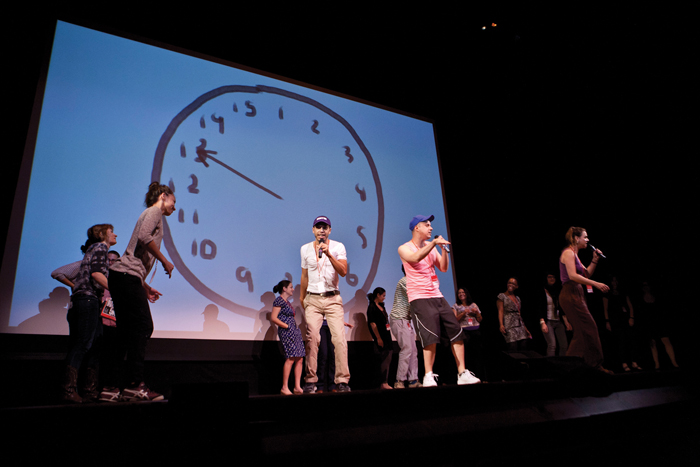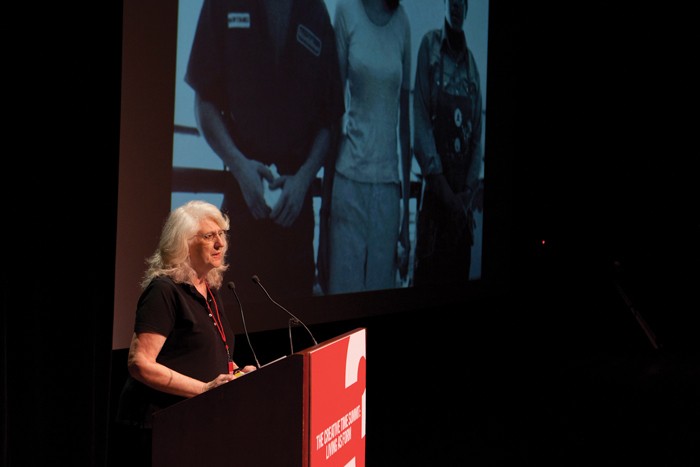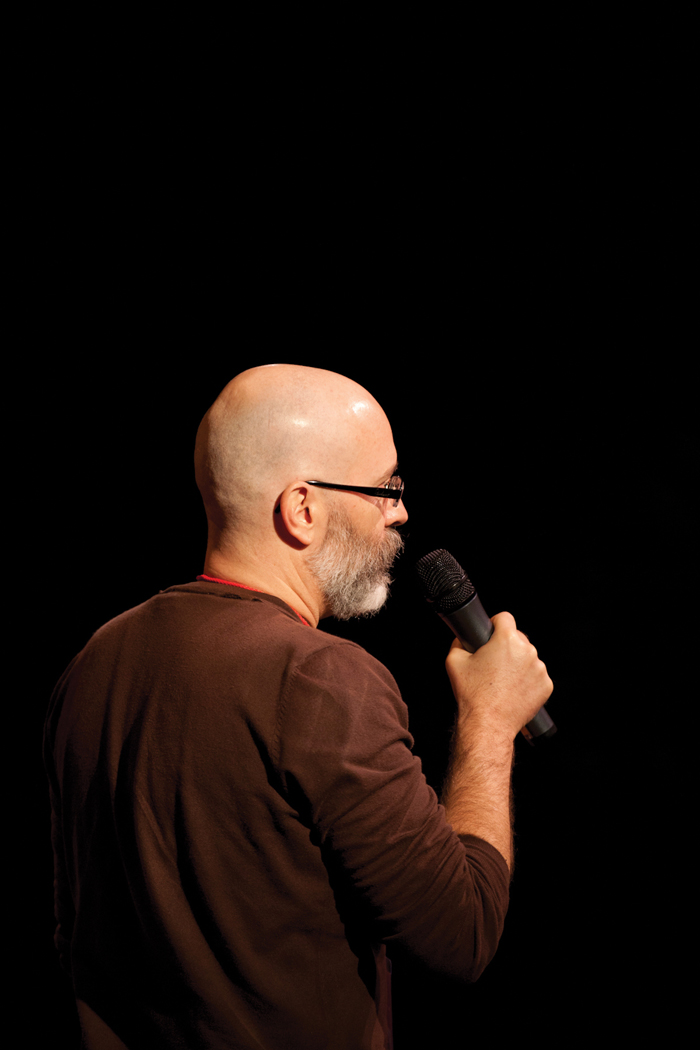23, 2011
The third Creative Time summit, titled “Living as Form,” brought together more than thirty activists, artists and collaboratives to present practices that might illuminate the “Living as Form” rubric and add to, if not begin to account for, the growing number of artists working in social and public spaces around the world. With 1000 attendees in the auditorium, the one-day event attracted more than double the audience members of the previous, 2010 summit. There were many others watching as well, with organized livestream events in Ann Arbor, Michigan; Charlottesville, Virginia; Dallas, Texas; Holon, Israel; Los Angeles; Mumbai; New Delhi; Portland, Oregon; and Toronto. The summit kicked off an exhibition by the same name that went on view for three weeks in the Historic Essex Street Market, and performances and events in locations in the surrounding neighborhood. This was the first Creative Time summit to be accompanied by such events, and it seemed that, although the projects were—for the most part—smart, provocative interventions that could be models for continuing socially-engaged actions, the energy that had been present in the two previous summits was somehow lessened or perhaps simply enervated by being distributed among different components.

My Barbarian kicks off the Creative Time Summit with a participatory performance. New York University Skirball Center for the Performing Arts, New York, September 23, 2011. Photo: Sam Horine. Courtesy Creative Time.
Creative Time is a small organization that, to their great credit, has always had an impact larger than their physical scale; this has been especially true since much of their program and resources became focused on curating socially and politically motivated practices. The organization was founded in 1973 to produce public art in all forms in New York City. As artistic practices and ideas about public space evolved, the organization also changed, presenting temporary and performance-based works in the 1990s, and more complex and expansive projects over the last ten or so years. Their current mission statement presents their purpose succinctly: to “commission, produce and present the most important, ground-breaking, challenging and exceptional art of our times; art that infiltrates the public realm and engages millions of people in New York City and across the globe.” A recent project, Paul Chan’s “Waiting for Godot,” produced in New Orleans in 2007 following the post-Katrina calamities, demonstrates this intention very well.
Creative Time chief curator and summit organizer Nato Thompson was careful to outline a non-critical position in the statements he wrote for the Living as Form website and the summit and exhibition texts, asserting his intention to take a broad, inclusive stance to “provide insights into this vast new terrain…a significant and growing form of cultural practice” and acknowledging that “it seems daunting to attempt to contain it under the heading of ‘art,’ as so much socially engaged cultural work exists outside this field.” This purposeful inclusiveness and not-just-art position was quite evident in the broad range of projects that were represented. Among the presenters were political activists, experimental media practitioners, visual artists, urban planners, performance artists, conceptual artists, architects, social interventionists, historians, and social justice workers.

Nato Thompson presents at the Creative Time Summit, New York University Skirball Center for the Performing Arts, New York, September 23, 2011. Photo: Sam Horine. Courtesy Creative Time.
The content of the presentations was almost always direct, engaging and inspiring. Among the standout presentations: a spellbinding video of several risky political actions by Voina, a Russian group with two hundred anonymous members; a slide show (that garnered a standing ovation) by Mierle Laderman Ukeles, who built an anthemic recitation of passages from her diary about what has fed her work over her long career; a talk by Carleton Turner about Alternate ROOTS’s work since 1976 using the arts to illuminate civil rights issues (he pointed out that Rosa Parks wasn’t simply a tired old lady, but a knowledgeable activist who prepared a strategy to fight racism); an eloquent and wry presentation about the popular demonstrations in Wisconsin by Dan S. Wang, who described the compelling concreteness of such projects as both matching and exceeding everyday life; and a heartfelt and articulate account of work “to provide a better world in which everyone has a stake” and in which everyone can “face a world in progress as creators not consumers” by Jeanne van Heeswijk (who was awarded Creative Time’s Lenore Annenberg Prize for Art and Social Change).1
Perhaps, as Purves gently suggested in his talk, different questions can be asked in order to develop commonalities that account for the shift towards engagement and new critical positions that are capable of framing the full range of social projects. It is a matter of further research and dialogue to evolve and articulate the issues that will illuminate these practices in all their differences—not as a cynical, corporatizing, moving-toward- an-academic-curriculum strategy, but as an attempt to understand the full scope of what is being generated and to get at structures, relationships, and their analysis as we do (or should do) with everything in public discourse. Inquiries and investigations such as this will not only enrich this expanded field in all its dimensions (rather than simply, or simplistically, enlarge it). They might reveal tensions not previously perceived as central or understood as impactful; they might posit new capacities and agencies, or open up a new horizon onto different intellectual and practical territories.

Mierle Laderman Ukeles speaks about her work as a self-proclaimed “Maintenance Artist” at the Creative Time Summit, New York University Skirball Center for the Performing Arts, New York, September 23, 2011. Photo: Sam Horine. Courtesy Creative Time.
And, finally, what about art? A significant conversation could be developed from this notable gap in the Living as Form Summit: the complete avoidance of any discussion of art, an oddity considering that it appeared that most of the audience was made up of artists, students, art teachers, and academics. The reluctance to call attention to the artistic aspect of these practices or to articulate or specify any aesthetic facet posed an odd conundrum, as if the summit organizers believed in a simplistic notion of art as elitist or, if not that, had based the summit on a unarticulated (and thus unshared) subscription to ideas such as Tania Bruguera’s arte útil.4And yet, one of the powerful experiences of the summit was the sense of empowered and active solidarity, an aesthetic of potent affect. The projects that engendered the greatest response were those that triggered the desire to participate: the Voina collective’s video of some of their political actions, whose true risk-taking induced waves of cheers; Laderman Ukeles’s speech—the story she told and the quickening rhythm with which she told it— infected the entire auditorium. These projects and objects pointed to process, and provided opportunities to share an array of authentic experiences; they used the power of imagining to create interventions and transform real situations. A significant commonality among the disparate projects of Living as Form was this tapping of a compelling imaginary in the broader audience who watched, inspired, from a distance. Ironically, this is what was precisely staged by the summit, but which was minimized and suspended by the lack of any kind of debate that included art, aesthetics, or the phenomena of the imaginary. These projects need to be discussed in aesthetic terms of performance and spectacle, in terms of motivations, and in terms of affect as well as result, in order to yield a more productive and generative engagement of the tensions among art, activism, aesthetics, politics, social agency, and real life.
Sheryl Conkelton is a curator and art historian living in Philadelphia. She teaches at Moore College of Art and Design.

